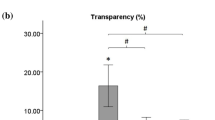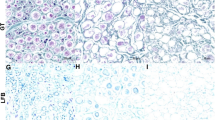Abstract
Injuries to the peripheral nerves represent a frequent cause of permanent disability in adults. The repair of large nerve lesions involves the use of autografts, but they have several inherent limitations. Overcoming these limitations, the use of decellularized nerve matrix has emerged as a promising treatment in tissue regenerative medicine. Here, we generate longer human decellularized nerve segments with a novel decellularization method, using nonionic, zwitterionic, and enzymatic incubations. Efficiency of decellularization was measured by DNA quantification and cell remnant analysis (myelin, S100, neurofilament). The evaluation of the extracellular matrix (collagen, laminin, and glycosaminoglycans) preservation was carried out by enzyme-linked immunosorbent assay (ELISA) or biochemical methods, along with histological and immunofluorescence analysis. Moreover, biomechanical properties and cytocompatibility were tested. Results showed that the decellularized nerves generated with this protocol have a concentration of DNA below the threshold of 50 ng/mg of dry tissue. Furthermore, myelin, S100, and MHCII proteins were absent, although some neurofilament remnants could be observed. Moreover, extracellular matrix proteins were well maintained, as well as the biomechanical properties, and the decellularized nerve matrix did not generate cytotoxicity. These results show that our method is effective for the generation of decellularized human nerve grafts. The generation of longer decellularized nerve segments would allow the understanding of the regenerative neurobiology after nerve injuries in both clinical assays and bigger animal models.
Graphical Abstract
Effective decellularization of human nerve matrix for regenerative medicine with a novel protocol. Combination of zwitterionic, non-ionic detergents, hyperosmotic solution and nuclease enzyme treatment remove cell remnants, maintain collagen, laminin and biomechanics without generating cytotoxic leachables.







Similar content being viewed by others
References
Adiguzel E, Yaşar E, Tecer D, Güzelküçük Ü, Taşkaynatan MA, Kesikburun S, Özgül A (2016) Peripheral nerve injuries: long term follow-up results of rehabilitation. J Back Musculoskelet Rehabil 29:367–371. https://doi.org/10.3233/BMR-160681
Angius D, Wang H, Spinner RJ, Gutierrez-Cotto Y, Yaszemski MJ, Windebank AJ (2012) A systematic review of animal models used to study nerve regeneration in tissue-engineered scaffolds. Biomaterials 33:8034–8039. https://doi.org/10.1016/j.biomaterials.2012.07.056
Belkas JS, Shoichet MS, Midha R (2004) Peripheral nerve regeneration through guidance tubes. Neurol Res 26:151–160. https://doi.org/10.1179/016164104225013798
Boriani F, Fazio N, Fotia C, Savarino L, Nicoli Aldini N, Martini L, Zini N, Bernardini M, Baldini N (2017) A novel technique for decellularization of allogenic nerves and in vivo study of their use for peripheral nerve reconstruction. J Biomed Mater Res - Part A 105:2228–2240. https://doi.org/10.1002/jbm.a.36090
Boucher A, Desforges M, Duquette P, Talbot PJ (2007) Long-term human coronavirus-myelin cross-reactive T-cell clones derived from multiple sclerosis patients. Clin Immunol 123:258–267. https://doi.org/10.1016/j.clim.2007.02.002
Carriel V, Scionti G, Campos F, Roda O, Castro B, Cornelissen M, Garzón I, Alaminos M (2017) In vitro characterization of a nanostructured fibrin agarose bio-artificial nerve substitute. J Tissue Eng Regen Med 11:1412–1426. https://doi.org/10.1002/term.2039
Chen P, Cescon M, Bonaldo P (2015) The role of collagens in peripheral nerve myelination and function. Mol Neurobiol 52:216–225
Crapo PM, Gilbert TW, Badylak SF (2011) An overview of tissue and whole organ decellularization processes. Biomaterials 32:3233–3243
Diogo CC, Camassa JA, Pereira JE, da Costa LM, Filipe V, Couto PA, Geuna S, Maurício AC, Varejão AS (2017) The use of sheep as a model for studying peripheral nerve regeneration following nerve injury: review of the literature. Neurol Res 39:926–939. https://doi.org/10.1080/01616412.2017.1331873
Ducic I, Fu R, Iorio ML (2012) Innovative treatment of peripheral nerve injuries. Ann Plast Surg 68:180–187. https://doi.org/10.1097/SAP.0b013e3182361b23
Fox IK, Mackinnon SE (2007) Experience with nerve allograft transplantation. Semin Plast Surg 21:242–249. https://doi.org/10.1055/s-2007-991194
Gao X, Wang Y, Chen J, Peng J (2013) The role of peripheral nerve ECM components in the tissue engineering nerve construction. Rev Neurosci 24:443–453. https://doi.org/10.1515/revneuro-2013-0022
García-Pérez MM, Martínez-Rodríguez HG, López-Guerra GG, Soto-Domínguez A, Said-Fernández SL, Morales-Ávalos R, Elizondo-Omaña RE, Montes-de-Oca-Luna R, Guzmán-López S, Castillo-Galván ML, Mendoza-Lemus OF, Vílchez-Cavazos F (2017) A modified chemical protocol of decellularization of rat sciatic nerve and its recellularization with mesenchymal differentiated schwann-like cells: morphological and functional assessments. Histol Histopathol 32:779–792. https://doi.org/10.14670/HH-11-844
Gilpin A, Yang Y (2017) Decellularization strategies for regenerative medicine: from processing techniques to applications. 2017:
Gonzalez-Perez F, Udina E, Navarro X (2013) Extracellular matrix components in peripheral nerve regeneration. Int Rev Neurobiol 108:257–275. https://doi.org/10.1016/B978-0-12-410499-0.00010-1
Gordon T, Borschel GH (2017) The use of the rat as a model for studying peripheral nerve regeneration and sprouting after complete and partial nerve injuries. Exp Neurol 287:331–347. https://doi.org/10.1016/j.expneurol.2016.01.014
Hudson TW, Liu SY, Schmidt CE (2004) Engineering an improved acellular nerve graft via optimized chemical processing. Tissue Eng 10:1346–1358. https://doi.org/10.1089/ten.2004.10.1346
Hudson TW, Zawko S, Deister C, Lundy S, Hu CY, Lee K, Schmidt CE (2004) Optimized Acellular nerve graft is immunologically tolerated and supports regeneration. Tissue Eng 10:1641–1651. https://doi.org/10.1089/ten.2004.10.1641
IJpma FFa, Nicolai J-P a, Meek MF (2006) Sural nerve donor-site morbidity: thirty-four years of follow-up. Ann Plast Surg 57:391–395. https://doi.org/10.1097/01.sap.0000221963.66229.b6
Kim JK, Do KY, Kim JO, Seo DH (2016) Development of a decellularization method to produce nerve allografts using less invasive detergents and hyper/hypotonic solutions. J Plast Reconstr Aesthetic Surg 69:1690–1696. https://doi.org/10.1016/j.bjps.2016.08.016
Langer V (2014) Management of major limb injuries. Sci, World J, p 2014
Lovati AB, D’Arrigo D, Odella S, Tos P, Geuna S, Raimondo S (2018) Nerve repair using decellularized nerve grafts in rat models. A review of the literature. Front Cell Neurosci 12:1–20. https://doi.org/10.3389/fncel.2018.00427
Mackinnon SE, Doolabh VB, Novak CB, Trulock EP (2001) Clinical outcome following nerve allograft transplantation. Plast Reconstr Surg 107:1419–1429. https://doi.org/10.1097/00006534-200105000-00016
Moradzadeh A, Borschel GH, Luciano JP, Whitlock EL, Hayashi A, Hunter DA, Mackinnon SE (2008) The impact of motor and sensory nerve architecture on nerve regeneration. Exp Neurol 212:370–376. https://doi.org/10.1016/j.expneurol.2008.04.012
Namgung U (2014) The role of Schwann cell-axon interaction in peripheral nerve regeneration. Cells Tissues Organs 200:6–12
Philips C, Campos F, Roosens A, del Sánchez-Quevedo M, C, Declercq H, Carriel V, (2018) Qualitative and Quantitative Evaluation of a Novel Detergent-Based Method for Decellularization of Peripheral Nerves. Ann Biomed Eng 46:1921–1937. https://doi.org/10.1007/s10439-018-2082-y
Philips C, Cornelissen M, Carriel V (2018) Evaluation methods as quality control in the generation of decellularized peripheral nerve allografts. J Neural Eng 15. https://doi.org/10.1088/1741-2552/aaa21a
Rathee P, Chaudhary H, Rathee S (2012) Immunosuppressants: A review
Sondell M, Lundborg G, Kanje M (1998) Regeneration of the rat sciatic nerve into allografts made acellular through chemical extraction. Brain Res 795:44–54. https://doi.org/10.1016/S0006-8993(98)00251-0
Squintani G, Bonetti B, Paolin A, Vici D, Cogliati E, Murer B, Stevanato G (2013) Nerve regeneration across cryopreserved allografts from cadaveric donors: a novel approach for peripheral nerve reconstruction. J Neurosurg 119:907–913. https://doi.org/10.3171/2013.6.JNS121801
Stagner AM, Jakobiec FA (2016) Peripheral nerve sheath tumors of the eyelid dermis: a clinicopathologic and immunohistochemical analysis. Ophthal Plast Reconstr Surg 32:40–45. https://doi.org/10.1097/IOP.0000000000000424
Szynkaruk M, Kemp SWP, Wood MD, Gordon T, Borschel GH (2013) Experimental and clinical evidence for use of decellularized nerve allografts in peripheral nerve gap reconstruction. 19. https://doi.org/10.1089/ten.teb.2012.0275
T. Ferreira WR (2012) ImageJ user guide 1.46r. IJ 146r 185. https://doi.org/10.1038/nmeth.2019
Taylor CA, Braza D, Rice JB, Dillingham T (2008) The incidence of peripheral nerve injury in extremity trauma. Am J Phys Med Rehabil 87:381–385. https://doi.org/10.1097/PHM.0b013e31815e6370
Thorsén F, Rosberg H-E, Steen Carlsson K, Dahlin LB (2012) Digital nerve injuries: epidemiology, results, costs, and impact on daily life. J Plast Surg Hand Surg 46:184–190. https://doi.org/10.3109/2000656X.2012.676554
Topp KS, Boyd BS (2006) Structure and biomechanics of peripheral nerves: nerve responses to physical stresses and implications for physical therapist practice. Phys, Ther
Tos P, Ronchi G, Papalia I, Sallen V, Legagneux J, Geuna S, Giacobini‐Robecchi MBT-IR of N (2009) Chapter 4 Methods and protocols in peripheral nerve regeneration experimental research: part i—experimental models. Academic Press, pp 47–79
Vasudevan S, Huang J, Botterman B, Matloub HS, Keefer E, Cheng J (2014) Detergent-free decellularized nerve grafts for long-gap peripheral nerve reconstruction. Plast Reconstr Surg Glob Open 2:e201. https://doi.org/10.1097/GOX.0000000000000118
Wang W, Itoh S, Takakuda K (2016) Comparative study of the efficacy of decellularization treatment of allogenic and xenogeneic nerves as nerve conduits. J Biomed Mater Res - Part A 104:445–454. https://doi.org/10.1002/jbm.a.35589
Webport S (2011) International Standard. Program 2009:
Whitlock EL, Tuffaha SH, Luciano JP, Yan Y, Hunter DA, Magill CK, Moore AM, Tong AY, Mackinnon SE, Borschel GH (2009) Processed allografts and type I collagen conduits for repair of peripheral nerve gaps. Muscle Nerve 39:787–799. https://doi.org/10.1002/mus.21220
Wilson ADH, Hart A, Brannstrom T, Wiberg M, Terenghi G (2003) Primary sensory neuronal rescue with systemic acetyl-L-carnitine following peripheral axotomy. A dose-response analysis. Br J Plast Surg 56:732–739. https://doi.org/10.1016/j.bjps.2003.08.005
Wu C, Tian D, Feng Y, Polak P, Wei J, Sharp A, Stankoff B, Lubetzki C, Zalc B, Mufson EJ, Gould RM, Feinstein DL, Wang Y (2006) A novel fluorescent probe that is brain permeable and selectively binds to myelin. J Histochem Cytochem 54:997–1004. https://doi.org/10.1369/jhc.5A6901.2006
Xing Q, Yates K, Tahtinen M, Shearier E, Qian Z, Zhao F (2015) Decellularization of fibroblast cell sheets for natural extracellular matrix scaffold preparation. Tissue Eng Part C Methods 21:77–87. https://doi.org/10.1089/ten.tec.2013.0666
Zilic L, Wilshaw SP, Haycock JW (2016) Decellularisation and histological characterisation of porcine peripheral nerves. Biotechnol Bioeng 113:2041–2053. https://doi.org/10.1002/bit.25964
Acknowledgments
We would like to thank the donors and their families which with their altruistic act of donation have allowed to perform this study. We would also like to thank transplant coordinators, donor center, and recovery teams for their efforts which make it possible to obtain the samples used in this study, and T. Van Eeckhout for his assistance in the final editing and preparation of this manuscript.
Funding
This work has been partially supported by grant from TERCEL (RD16/0011/0035) and CIBERNED (CB06/05/1105) from the Instituto de Salud Carlos III (Madrid, Spain), and internal competitive grant from BST (Ref I.2017.056).
Author information
Authors and Affiliations
Contributions
N.N.N. designed, performed experiments, analyzed data, wrote the manuscript, and final approval of the manuscript for publication. L.C.P., F.O., C.M.R., and V.A. critically revised the manuscript. B.S. performed experiments and analyzed data. U.E. and N.X. analyzed data and critically revised the manuscript.
Corresponding author
Ethics declarations
Conflict of interest
The authors declare that they have no conflict of interest.
Ethical approval
This study followed the ethical precepts of the Declaration of Helsinki (Fortaleza, Brazil, October 2013) and was approved by our local ethics committee (CEIC, Hospital Clinic de Barcelona; Ref 7365-12). Human samples were obtained, processed, and analyzed according to current guidance in relation to the collection and preservation of human tissues for clinical use (EEC regulations 2004/23/CE and 2006/17/CE) and in accordance with the protocol and legal requirements for the use of biological samples and biomedical research in Spain (Law 14/2007 and RD 1716/2011). In addition, the acquisition, processing, and preservation of the tissues of this study are in accordance with the Spanish Laws that regulates the quality and safety standards for donation, procurement, evaluation, processing, preservation, storage, and distribution of human cells and tissues (RD 9/2014).
Informed consent
All the information provided before donation, together with informed consent, stressed that the samples obtained were to be used for clinical application and/or applied research. The use, protection, communication, and transfer of personal data complied with local regulations (Law 15/1999).
Additional information
Publisher’s Note
Springer Nature remains neutral with regard to jurisdictional claims in published maps and institutional affiliations.
Electronic supplementary material
Below is the link to the electronic supplementary material.
Rights and permissions
About this article
Cite this article
Nieto-Nicolau, N., López-Chicón, P., Fariñas, O. et al. Effective decellularization of human nerve matrix for regenerative medicine with a novel protocol. Cell Tissue Res 384, 167–177 (2021). https://doi.org/10.1007/s00441-020-03317-3
Received:
Accepted:
Published:
Issue Date:
DOI: https://doi.org/10.1007/s00441-020-03317-3




